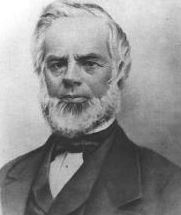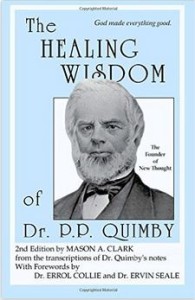All illness has a psycho-somatic component. Often it’s hard to tell where the boundary lies between the mind and body. One great pioneering healer knew no bounds; his name was Phineas Parkhurst Quimby.
He was born on February 16, 1802. He was a clock-maker in Belfast, Maine, where he lived most of his life. Although others called him ‘Doctor’ he had little formal education, and no medical training or qualifications. But he had a practical, enquiring mind.
As a young man, he became desperately ill with tuberculosis. His lungs were wasting away and doctors couldn’t help. He decided to try and help himself. Someone suggested horse-riding – the fresh air would do him good. But he was too weak to ride a horse, so be borrowed a horse and cart. One day the horse refused to pull the cart up a hill, so Quimby walked up the hill with the horse. When they got to the top, the horse suddenly started trotting. Quimby couldn’t get back on the cart and ran down the hill with the horse – which, strictly speaking, he shouldn’t have been able to.
When he got home, he realised he was breathing freely and the pain had gone. It never returned. He dedicated the rest of his life to understanding what brought this spontaneous healing about. He reasoned there must be something within us, that we’re not normally aware of, that can make us well.
He learned of the work of Anton Mesmer, the hypnotist, who had gained a reputation for remarkable healings in Europe. By 1840, Quimby was an expert hypnotist. He met a young man called Lucius who was an excellent hypnotic subject. Under hypnosis, Lucius could apparently diagnose patients’ illnesses and suggest a cure.
Later, Quimby realized that Lucius was tuning in to what the patient believed he had, not what he actually had. So after his early experiments, he gave up hypnotism. Instead, he focussed on curing disease through the mind (mental healing). His emphasis was on getting his patients to see causes for themselves. He wanted to help the patient see life in an entirely different way. About this time, his own clairvoyant faculties began to develop.
He dedicated himself to discovering the truth behind the New Testament healings. In the gospels, Jesus was said to heal first the mind, then the body. He removed the cause of the disease and the physical effect ceased. Quimby did not regard Jesus’ healings as miracles, but as scientific applications of Universal Law.
Many thought him a charlatan, but those he helped saw him as a pioneer, a mystic. He healed thousands of people of a wide range of illnesses. He also carried out distance healing. Most of his cases had not responded to conventional treatment. Some thought he was most successful among the credulous, but there’s no doubt he brought about many marvellous cures.
He died of over-work and self-neglect on January 16, 1866. It is said he saw over 10,000 patients in his last seven years. Later writers attributed his success to four main factors:
1. He had a deep sympathy for human suffering.
2. He was an authentic and original thinker. It took a great deal of courage to do what he did and teach what he taught in 19th Century New England.
3. His approach was rigorously scientific. He demanded proof and did not trust opinions, only knowledge.
4. He understood the harm that organised religion of his day had done to people and the need to reverse this thinking. He believed that the Church had abdicated its interest in healing and that his purpose was to resurrect it. His interest in the New Testament was mainly to understand the negative thinking of his patients – especially those who believed that ill health was normal or that they were ill because G_d was punishing them for some unpardonable sin.
Quimby’s Healing Method
Quimby believed that the healing power is present in the mind of the patient. He sat down with his patients and put himself in rapport with them. He addressed his comments to the ‘spirit within’. He held that the spirit within is at one with G_d and never sick.
He used his intuition to discover the real source of the problem. He visualised the person’s spirit form standing beside the body. The spirit form imparted to him the cause of the problem. Often he felt every symptom of the disease in his own body.
He described the cause of disease in his own words:
“The trouble is in the mind, for the body is only the house for the mind to dwell in. if your mind has been deceived by some invisible enemy into a belief, you have put it into the form of a disease, with or without your knowledge. By my theory or truth I come in contact with your enemy and restore you to health and happiness….
A sick man is like a criminal cast into prison for disobeying some law that man has set up. I plead his case, and if I get the verdict, the criminal is set at liberty. If I fail, I lose the case. His own judgment is his judge, his feelings are his evidence. If my explanation is satisfactory to the judge, you will give me the verdict. This ends the trial, and the patient is released.”
His son George (who acted as his secretary) described his father’s method of cure like this (I paraphrase): ‘A patient comes to see Dr Quimby. He renders himself absent to everything but the impression of the person’s feelings. These are quickly imprinted on him. This mental picture contains the disease as it appears to the patient. Being confident that it is the shadow of a false idea, he is not afraid of it. Then his feelings in regard to health and strength are imprinted on the receptive plate of the patient. The patient sees the disease in a new light, gains confidence. This change is imprinted on the doctor again and he sees the change and continues. The shadow grows dim and finally disappears, the light takes its place, and there is nothing left of the disease.’
Sometimes barely a word was spoken – Quimby’s thoughts somehow impacted on the patient. Quimby’s highly developed intuition and powers of concentration were vital in his success. Today he would be called a medical intuitive, because he could ‘sense’ what the problem was and sometimes apply a remedy by telepathy.
He knew – predating Freud by half a century – that many of the patient’s unhelpful beliefs were located in the Unconscious Mind and must be brought into consciousness before they can be dealt with. The Unconscious is directly responsive to thought and embodies our fears, beliefs, hopes, errors, and joys. Thought, emotion and belief all impact on health, and these can be changed. Quimby found that the most harmful belief – which he encountered a great deal – was that G_d was punishing the person for their sins by making them ill.
Writings
Quimby left behind detailed journals which explained his philosophy and methods. In addition, some of his clients published their own books and devoted their lives to spreading awareness of his discoveries. The main one was Rev Warren Felt Evans. He wrote the definitive contemporary account in his book, ‘The Mental Cure’ (1869). His ideas also found their way into the writings of Mrs Mary Baker Eddy, whose most famous work, ‘Science and Health’, was published in 1875. (more on her later)
Quimby didn’t publish his writings. After his death, his son George held on to his manuscripts but refused to publish them until after Mrs Eddy’s death. Only in 1920 were edited excerpts published (by Horatio Dresser, son of Julius Dresser, a patient), but it was not until 1989 that Phineas Parkhurst Quimby: The Complete Writings were published, edited by Dr Ervin Seale, who devoted much of his life to this task.
Every New Thought thinker and writer has been influenced by Quimby, and so have many of the great psychologists and philosophers including the Louise Hay, Milton Erickson, Caroline Myss, Bandler and Grinder (NLP), Ernest Holmes, the Cognitive-Behavioural therapists and many others. Most acknowledge their debt.
Piano keys
Quimby was far ahead of his time. One of his most famous sayings is, ‘Take a piano. The same keys that produce discord will produce harmony.’ What did he mean? Simply that the same laws of thought and belief that can produce discord and misery can also produce harmony and happiness.
At last people are waking up to the incredible contribution he made. Science is still catching up, and one day – hopefully before too long – it will.
©David Lawrence Preston, 2015
Follow me on Facebook and Twitter @Feelinggoodatt
Visit www.feelinggoodallthetime.com






